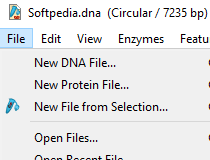

- SNAPGENE VIEWER TRANSLATION HOW TO
- SNAPGENE VIEWER TRANSLATION SOFTWARE
- SNAPGENE VIEWER TRANSLATION FREE
SnapGene SnapGene Viewer 6.2.2 PDF-XChange Editor 9.5.368.0. SnapGene Viewer has had 3 updates within the past 6 months. SnapGene File: Plasmid sequence and SnapGene aprilia 1100 tuono v4. ORFs and protein translations - translate DNA sequences. SnapGene Viewer allows molecular biologists to create, browse, and share richly annotated DNA sequence files up to 1Gb in length.Visualize: Create a DNA sequence file by either entering a sequence, or importing a record from GenBank, or opening an annotated sequence stored in one of many common file formats.
SNAPGENE VIEWER TRANSLATION SOFTWARE
Share: export a plasmid map as an image, or export an annotated DNA sequence to GenBank format and freely share data with your colleagues or customers using the universally accessible SnapGene format. Lingoes is a dictionary and multi-language translation software providing results in over. Reverse Translate - Bioinformatics Translation elongation factor 1- gene as a. fa files or export sequences as a Genebank, Fastq or Teselagen JSON file. Annotate: automatically annotate common features, or manually annotate coding sequences and other features, design and annotate primers for PCR, sequencing, or mutagenesis, and identify open reading frames (ORFs) with a single mouse click.
SNAPGENE VIEWER TRANSLATION HOW TO
Watch these step-by-step video guides and learn how to simulate all major molecular cloning techniques in SnapGene. Watch our easy to follow videos and learn how annotate features, create primers, simulate PCR and perform silent mutations.

SnapGene automatically generates a record of every sequence edit and cloning procedure, so you won’t lose track of how a construct was made, even after a lab member leaves.
SNAPGENE VIEWER TRANSLATION FREE
Search a DNA sequence to match either a DNA query, or a protein translation, or an annotation. We developed a few short videos to get you started. dna files can be opened by the free cross-platform SnapGene Viewer, enabling you to share richly annotated maps and sequences with colleagues. Browse or print a DNA sequence and its annotations using customizable Map, Sequence, Enzymes, Features, Primers, and History views. the enriched in GO:BP terms of Defense response to virus, Translation.

Features include visualize: Create a DNA sequence file by either entering a sequence, or importing a record from GenBank, or opening an annotated sequence stored in one of many common file formats. sequences using SnapGene (GSL Biotech, LLC, San Diego, CA, USA). Browse or print a DNA sequence and its annotations using customizable Map, Sequence, Enzymes, Features, Primers, and History views. Identify open reading frames (ORFs) with a mouse click.Įxport a plasmid map as an image, or export an annotated DNA sequence to GenBank format.įreely share data with your colleagues or customers using the universally accessible SnapGene format.SnapGene Viewer is software that allows molecular biologists to create, browse, and share richly annotated DNA sequence files up to 1 GB in length. In this tutorial, you will learn how SnapGene can help you view and edit translated features, open reading frames, and whole sequence translations. Free software that allows you to create, browse, and share richly annotated sequence files. Thanks to the free SnapGene Viewer, the files can be shared with our. (1) To turn on translation, either click the check box, or choose 'CDS' (coding sequence) as the feature type. Search a DNA sequence to match either a DNA query, a protein translation, or an annotation.Īutomatically annotate common features or manually annotate coding sequences and other features.ĭesign and annotate primers for PCR, sequencing, or mutagenesis. and by helping to translate knowledge into technological innovations with both. SnapGene Viewer allows molecular biologists to create, browse, and share richly annotated DNA sequence files up to 1GB in length.Ĭreate a DNA sequence file by either entering a sequence, importing a record from GenBank, or opening an annotated sequence stored in one of many common file formats.īrowse or print a DNA sequence and its annotations using customizable Map, Sequence, Enzymes, Features, Primers, and History views.


 0 kommentar(er)
0 kommentar(er)
